英语学科知识与教学能力考点必背语音部分教师资格证修订版
教师资格证《英语学科知识与教学能力(初级中学)》(题库)模拟试卷四
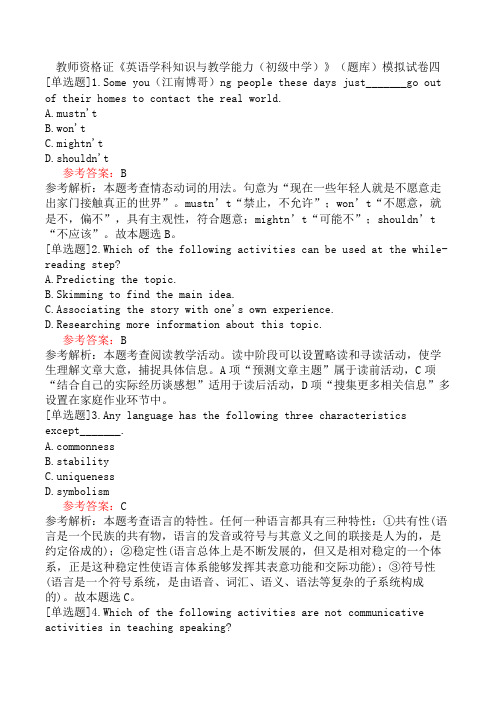
教师资格证《英语学科知识与教学能力(初级中学)》(题库)模拟试卷四[单选题]1.Some you(江南博哥)ng people these days just_______go out of their homes to contact the real world.A.mustn'tB.won'tC.mightn'tD.shouldn't参考答案:B参考解析:本题考查情态动词的用法。
句意为“现在一些年轻人就是不愿意走出家门接触真正的世界”。
mustn’t“禁止,不允许”;won’t“不愿意,就是不,偏不”,具有主观性,符合题意;mightn’t“可能不”;shouldn’t “不应该”。
故本题选B。
[单选题]2.Which of the following activities can be used at the while-reading step?A.Predicting the topic.B.Skimming to find the main idea.C.Associating the story with one's own experience.D.Researching more information about this topic.参考答案:B参考解析:本题考查阅读教学活动。
读中阶段可以设置略读和寻读活动,使学生理解文章大意,捕捉具体信息。
A项“预测文章主题”属于读前活动,C项“结合自己的实际经历谈感想”适用于读后活动,D项“搜集更多相关信息”多设置在家庭作业环节中。
[单选题]3.Any language has the following three characteristics except_______.monnessB.stabilityC.uniquenessD.symbolism参考答案:C参考解析:本题考查语言的特性。
英语学科知识与能力考试重点

英语学科知识与教学能力预测一、语音知识1.元音vowel[i:] high front tense unrounded vowel[І] high front lax unrounded vowel[u:] high back tense rounded vowel[ʊ]即[u] high back lax rounded vowel[З:]或[ə:] central tense unrounded vowel[ə] central lax unrounded vowel[e] mid-high front lax unrounded vowel[æ] low front lax unrounded vowel[Λ] mid-low back lax unrounded vowel[ɔ:] mid-low back tense rounded vowel[ɒ] low back lax rounded vowel[ɑ:] low back tense unrounded vowel双元音Diphthongs [eI] [aI] [ɔI] [əʊ] [aʊ] [Iə] [eə] [ʊə]A double movement produces 三元音Triphthong例如:tower中[aʊə]【答案】D。
解析:本题考查时态。
四个选项中都有连词and连接两个时态,因此前后必须相互搭配,而ABC三项的前后两种时态搭配不当,因此选择D,现在完成时和将来时。
本句意思是:作为一名公民Marsha意识到并且会一直明白自己的道德义务。
2. Potential subjects should be informed of the research and _____ an opportunity to decide if they want to participate.A. gaveB. givingC. giveD. be given【答案】D。
(中学教师资格考试)英语学科知识与教学能力
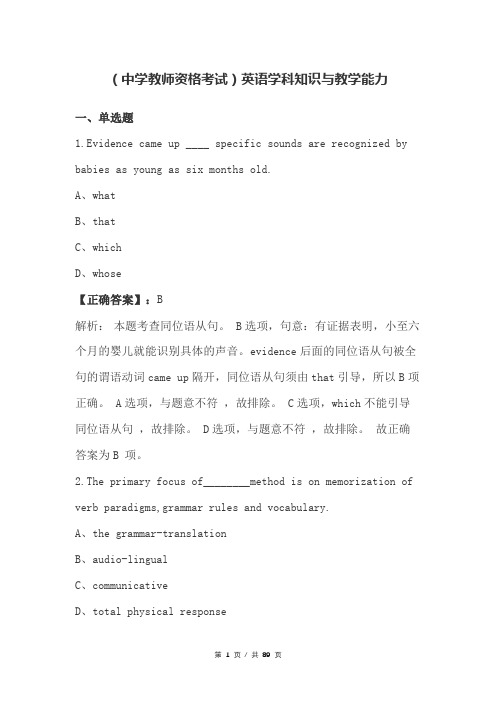
(中学教师资格考试)英语学科知识与教学能力一、单选题1.Evidence came up ____ specific sounds are recognized by babies as young as six months old.A、whatB、thatC、whichD、whose【正确答案】:B解析:本题考查同位语从句。
B选项,句意:有证据表明,小至六个月的婴儿就能识别具体的声音。
evidence后面的同位语从句被全句的谓语动词came up隔开,同位语从句须由that引导,所以B项正确。
A选项,与题意不符,故排除。
C选项,which不能引导同位语从句,故排除。
D选项,与题意不符,故排除。
故正确答案为B 项。
2.The primary focus of________method is on memorization of verb paradigms,grammar rules and vocabulary.A、the grammar-translationB、audio-lingualC、communicativeD、total physical response【正确答案】:A解析:本题考查语法翻译法 A选项,语法翻译法的主要教学方法是教师讲解与分析句子成分、语音、词汇变化及语法规则,要求学生记忆和运用规则解释课文。
综上,A选项正确。
B选项,听说法,故排除。
C选项,交际的,故排除。
D选项,全身反应法,故排除。
故正确答案为A 项。
3.?In the Communicative classrooms, the teacher might be a"________"---engaging in communicative activities along with students.A、co-communicatorB、co-instructorC、co-learnerD、co-performer【正确答案】:A解析:本题考查教学实施中教师的角色。
教师资格证《英语学科知识与教学能力(初级中学)》(题库)模拟试卷二
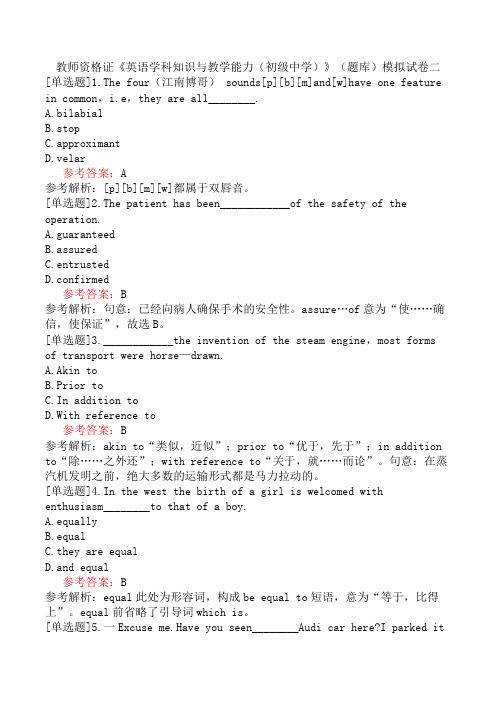
教师资格证《英语学科知识与教学能力(初级中学)》(题库)模拟试卷二[单选题]1.The four(江南博哥) sounds[p][b][m]and[w]have one feature in common,i.e,they are all________.A.bilabialB.stopC.approximantD.velar参考答案:A参考解析:[p][b][m][w]都属于双唇音。
[单选题]2.The patient has been____________of the safety of the operation.A.guaranteedB.assuredC.entrustedD.confirmed参考答案:B参考解析:句意:已经向病人确保手术的安全性。
assure…of意为“使……确信,使保证”,故选B。
[单选题]3.____________the invention of the steam engine,most forms of transport were horse—drawn.A.Akin toB.Prior toC.In addition toD.With reference to参考答案:B参考解析:akin to“类似,近似”;prior to“优于,先于”;in addition to“除……之外还”;with reference to“关于,就……而论”。
句意:在蒸汽机发明之前,绝大多数的运输形式都是马力拉动的。
[单选题]4.In the west the birth of a girl is welcomed with enthusiasm________to that of a boy.A.equallyB.equalC.they are equalD.and equal参考答案:B参考解析:equal此处为形容词,构成be equal to短语,意为“等于,比得上”。
教师资格证《英语学科知识与教学能力(高级中学)》(题库)模拟试卷二
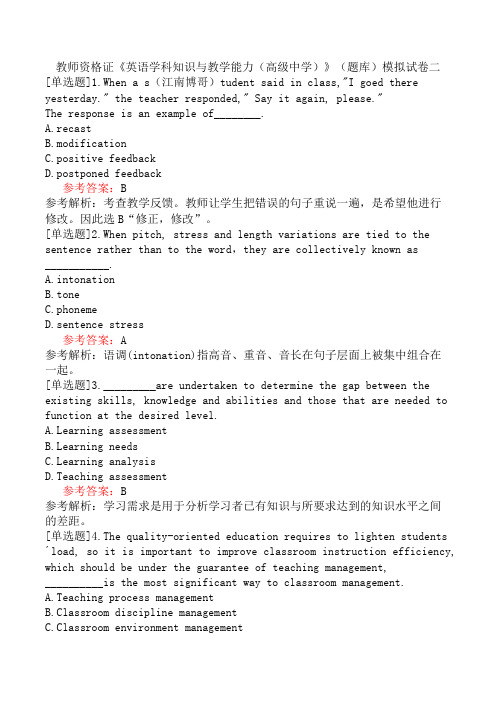
教师资格证《英语学科知识与教学能力(高级中学)》(题库)模拟试卷二[单选题]1.When a s(江南博哥)tudent said in class,"I goed there yesterday." the teacher responded," Say it again, please."The response is an example of________.A.recastB.modificationC.positive feedbackD.postponed feedback参考答案:B参考解析:考查教学反馈。
教师让学生把错误的句子重说一遍,是希望他进行修改。
因此选B“修正,修改”。
[单选题]2.When pitch, stress and length variations are tied to the sentence rather than to the word,they are collectively known as___________.A.intonationB.toneC.phonemeD.sentence stress参考答案:A参考解析:语调(intonation)指高音、重音、音长在句子层面上被集中组合在一起。
[单选题]3._________are undertaken to determine the gap between the existing skills, knowledge and abilities and those that are needed to function at the desired level.A.Learning assessmentB.Learning needsC.Learning analysisD.Teaching assessment参考答案:B参考解析:学习需求是用于分析学习者已有知识与所要求达到的知识水平之间的差距。
2025年教师资格证考试《英语学科知识与教学能力》(高级中学)模拟试卷
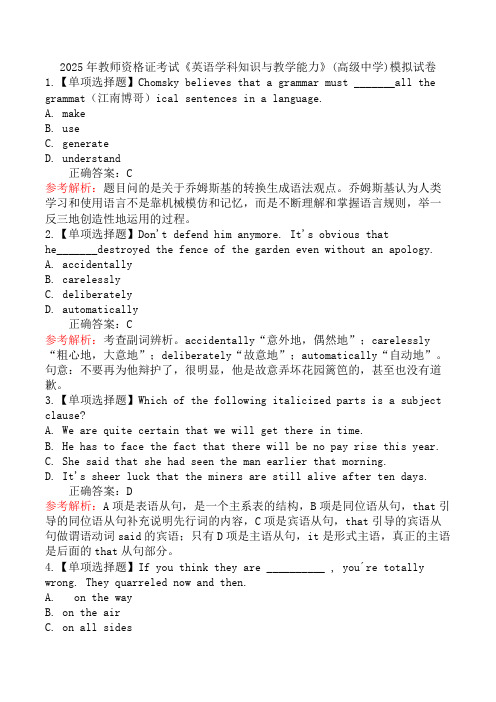
2025年教师资格证考试《英语学科知识与教学能力》(高级中学)模拟试卷1.【单项选择题】Chomsky believes that a grammar must _______all the grammat(江南博哥)ical sentences in a language.A. makeB. useC. generateD. understand正确答案:C参考解析:题目问的是关于乔姆斯基的转换生成语法观点。
乔姆斯基认为人类学习和使用语言不是靠机械模仿和记忆,而是不断理解和掌握语言规则,举一反三地创造性地运用的过程。
2.【单项选择题】Don't defend him anymore. It's obvious thathe_______destroyed the fence of the garden even without an apology.A. accidentallyB. carelesslyC. deliberatelyD. automatically正确答案:C参考解析:考查副词辨析。
accidentally“意外地,偶然地”;carelessly “粗心地,大意地”;deliberately“故意地”;automatically“自动地”。
句意:不要再为他辩护了,很明显,他是故意弄坏花园篱笆的,甚至也没有道歉。
3.【单项选择题】Which of the following italicized parts is a subject clause?A. We are quite certain that we will get there in time.B. He has to face the fact that there will be no pay rise this year.C. She said that she had seen the man earlier that morning.D. It's sheer luck that the miners are still alive after ten days.正确答案:D参考解析:A项是表语从句,是一个主系表的结构,B项是同位语从句,that引导的同位语从句补充说明先行词的内容,C项是宾语从句,that引导的宾语从句做谓语动词said的宾语;只有D项是主语从句,it是形式主语,真正的主语是后面的that从句部分。
2022下半年教师资格证考试《英语学科知识与教学能力》(初级中学)真题
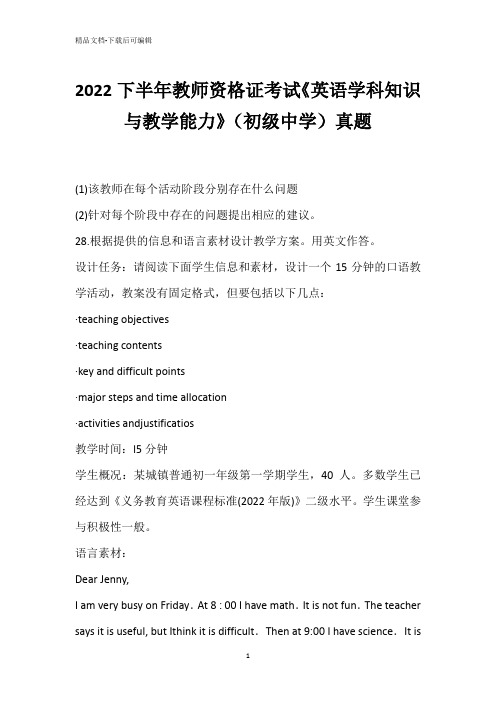
2022下半年教师资格证考试《英语学科知识与教学能力》(初级中学)真题(1)该教师在每个活动阶段分别存在什么问题(2)针对每个阶段中存在的问题提出相应的建议。
28.根据提供的信息和语言素材设计教学方案。
用英文作答。
设计任务:请阅读下面学生信息和素材,设计一个15分钟的口语教学活动,教案没有固定格式,但要包括以下几点:·teaching objectives·teaching contents·key and difficult points·major steps and time allocation·activities andjustificatios教学时间:l5分钟学生概况:某城镇普通初一年级第一学期学生,40人。
多数学生已经达到《义务教育英语课程标准(2022年版)》二级水平。
学生课堂参与积极性一般。
语言素材:Dear Jenny,I am very busy on Friday.At 8 : 00 I have math.It is not fun.The teacher says it is useful, but Ithink it is difficult.Then at 9:00 I have science.It isdifficult but interesting.At 10:00 I have his-tory.After that, I have P.E.at 11:00.It′ s easy and fun.Lunch is from 12:00 to 1:00, and after thatwe have Chinese.It is my favorite subject.Our Chinese teacher, Mr.Wang, is great fun.My classesfinish at 1 : 50, but after that I have an art lesson for two hours.It is really relaxing! How about youWhen are your classes What is your favorite subjectYour friend,Yu Mei。
国家教师资格考试英语学科知识与教学能力考试重点
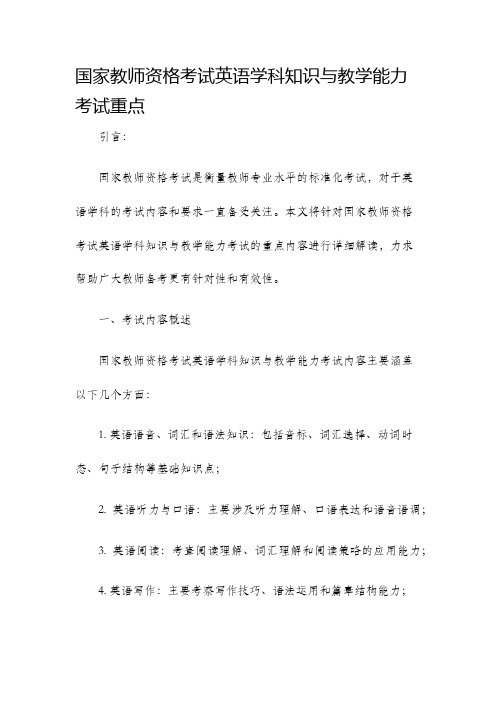
国家教师资格考试英语学科知识与教学能力考试重点引言:国家教师资格考试是衡量教师专业水平的标准化考试,对于英语学科的考试内容和要求一直备受关注。
本文将针对国家教师资格考试英语学科知识与教学能力考试的重点内容进行详细解读,力求帮助广大教师备考更有针对性和有效性。
一、考试内容概述国家教师资格考试英语学科知识与教学能力考试内容主要涵盖以下几个方面:1. 英语语音、词汇和语法知识:包括音标、词汇选择、动词时态、句子结构等基础知识点;2. 英语听力与口语:主要涉及听力理解、口语表达和语音语调;3. 英语阅读:考查阅读理解、词汇理解和阅读策略的应用能力;4. 英语写作:主要考察写作技巧、语法运用和篇章结构能力;5. 英语教学理论:包括教学基本原则、教学过程设计和教学方法等;6. 英语教材分析与评价:考察教师对教材的分析能力和教材适用性的评价;7. 英语教学设计与实施:主要考查教师的课程设计能力、教学组织能力和教学实施能力;8. 英语教学评价与反思:考察教师对学生学习效果的评估和教学反思的能力。
二、重点内容解析针对国家教师资格考试英语学科知识与教学能力考试,以下内容为重点:1. 英语语音、词汇和语法知识英语语音、词汇和语法是英语学习的基础,重点内容包括音标的掌握、常用词汇的理解和应用、常见句子结构和语法规则的掌握等。
考生需要熟练掌握各个语音、词汇和语法知识点,并能灵活运用于教学实践中。
2. 英语听力与口语英语听力与口语能力是英语学科的重要组成部分,考生需要具备良好的听力理解和口语表达能力。
建议考生通过大量的听力练习,并进行口语训练,提高自己的听说能力。
3. 英语阅读英语阅读能力是理解和运用英语知识的重要手段,考生需要培养自己的阅读理解能力和词汇理解能力。
建议考生多读一些英文材料,积累词汇量,并学会合理运用阅读策略,提高阅读效率。
4. 英语写作英语写作能力是考察考生综合运用英语语言知识的一个方面,考生需要掌握写作技巧、语法运用和篇章结构,培养自己的写作能力。
2019 上半年教师资格证考试《英语学科知识与教学能力》(初级中学
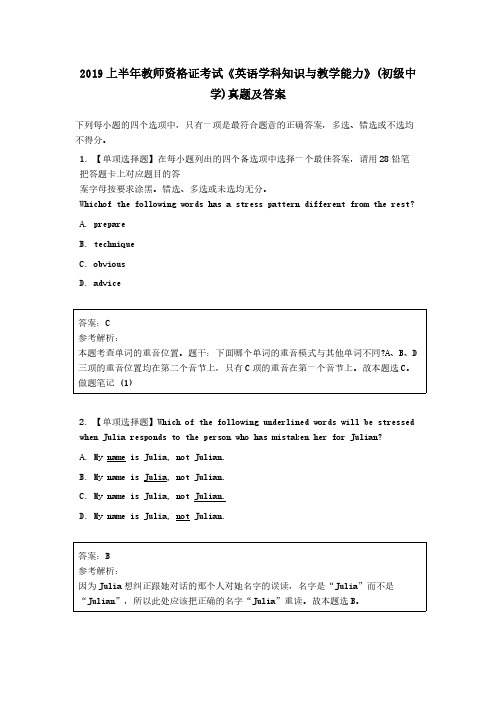
2019上半年教师资格证考试《英语学科知识与教学能力》(初级中学)真题及答案下列每小题的四个选项中,只有一项是最符合题意的正确答案,多选、错选或不选均不得分。
1.【单项选择题】在每小题列出的四个备选项中选择一个最佳答案,请用28铅笔把答题卡上对应题目的答案字母按要求涂黑。
错选、多选或未选均无分。
Whichof the following words has a stress pattern different from the rest?A.prepareB.techniqueC.obviousD.advice答案:C参考解析:本题考查单词的重音位置。
题干:下面哪个单词的重音模式与其他单词不同?A、B、D 三项的重音位置均在第二个音节上,只有C项的重音在第一个音节上。
故本题选C。
做题笔记(1)2.【单项选择题】Which of the following underlined words will be stressed when Julia responds to the person who has mistaken her for Julian?A.My name is Julia,not Julian.B.My name is Julia,not Julian.C.My name is Julia,not Julian.D.My name is Julia,not Julian.答案:B参考解析:因为Julia想纠正跟她对话的那个人对她名字的误读,名字是“Julia”而不是“Julian”,所以此处应该把正确的名字“Julia”重读。
故本题选B。
3.【单项选择题】Theword“UNESCO”is called a(n)_______.A.acronymB.blendC.clipped wordD.coined word答案:A参考解析:本题考查构词法。
A项“首字母缩略词”指由几个单词的首字母派生出来的新词;B 项意为“混成词”;C项意为“截断词”;D项意为“新创词”。
英语学科知识与教学能力考点必背(语音部分)教师资格证
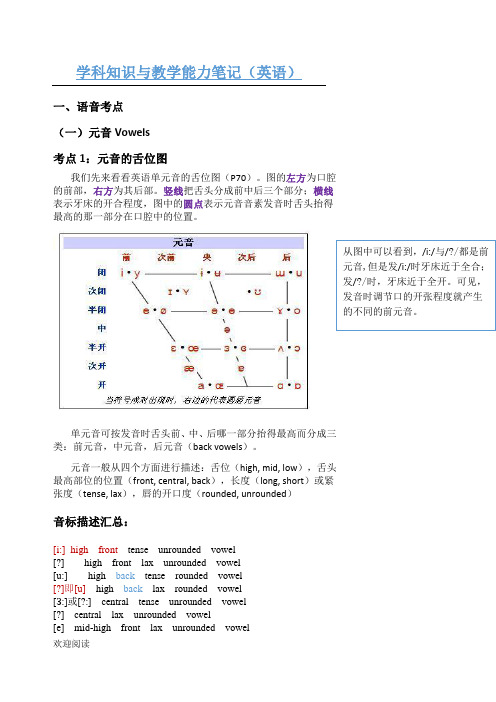
学科知识与教学能力笔记(英语)一、语音考点(一)元音Vowels考点1:元音的舌位图我们先来看看英语单元音的舌位图(P70)。
图的左方为口腔的前部,右方为其后部。
竖线把舌头分成前中后三个部分;横线音标描述汇总:[i:] h igh front tense unrounded vowel[?] high front lax unrounded vowel[u:] high back tense rounded vowel[?]即[u] high back lax rounded vowel[З:]或[?:] central tense unrounded vowel[?] central lax unrounded vowel[e] mid-high front lax unrounded vowel[?] low front lax unrounded vowel [Λ] mid-low back lax unrounded vowel [?:] mid-low back tense rounded vowel [?] low back lax rounded vowel [ɑ:] low back tense unrounded vowel考点2:专有名词基本元音 Cardinal Vowels纯元音Pure Vowels/单元音 Monophthong Vowels如:[aI] 中[a 考点1:Manners of articulation 发音方式 stops 爆破音 [p, b, t, d, k, g] nasal 鼻音 [m, n, ?]fricative 摩擦音 [f, v, θ, e, s, z, ∫, ?, h]、approximant近似音[w, r, j ]、lateral边音[l]、affricate塞擦音[ts, dz, tr, dr]考点2:Places of articulation发音部位[p][b][t][d][k][g][m][n][?][f][v][?][e][s][z][∫] voiceless postalveolar fricative[?] voiced postalveolar fricative[h] glottal fricative[t∫] voiceless postalveolar affricate [d?] voiced postalveolar affricate[l ] alveolar lateral[r] alveolar approximant[w] bilabial approximant[j] palatal approximant(三)Assimilation同化现象:a process by which one sound takes on some or all characteristics of a neighboring sound.Nasalization鼻音化、cap canDentalization齿音、tent tenthVelarization软腭since sinkVoiced frication有声擦音→voiceless无声擦音/__voiceless清音重音。
初中英语教资考试知识点超详细考点总结

第一部分语言知识与能力第一章英语语言知识二、语音(Speech Sounds)P781、语音分类发音方式发音部位VL - 清浊音(voiceless consonant) VD - 浊辅音(voiced consonant)2、音系学(phonology)P79(1)同化规则(assimilation Rule)progressive assimilation 顺同化(前面带偏后面)workedregressive assimilation 逆同化(后面带偏前面)newspaperreciprocal/double assimilation 互相同化 did you(2)音节(syllable) tea chi-na im-pos-si-ble重音(stress)声调(tone)(3)语音变化(vocal variety)liaison 连读 pick it upplosion 爆破音plosion loss 失去爆破 sit down ;incomplete plosion 不完全爆破 ask ed nasal plosion 鼻腔爆破 button ;lateral plosion 舌边爆破 little三、形态学(Morphology)1、morpheme 词素重点! P87(1)free morpheme 自由词素 dog ;bound morpheme 黏着词素 moonwalk(2)root 词根; affix 词缀(prefix 前缀、suffix 后缀); stem 词干friend-ships(3)inflectional affix 屈折词缀 -s,-ing,-ed不同形式(4)derivational affix 派生词缀改变词性和意义2、(1)inflection 屈折变化 -s,-ing,-ed不同形式(2)word-formation 词的形成:compounding 复合法 through-outderivation 派生法(prefixation 前缀化 suffixation 后缀化)il-logical-ly3、常见构词法P89invention 新创词 nylon ;blending 混成法 smoke+fog=smogclipping 截断法 advertisement=ad ;initialism 首字母连写词 WTOacronym 首字母拼音词 AIDS ;back-formation 逆构词法 editor--editanalogical creation 类似构词 work--wrought/workedtypes of borrowing 借词法:loanword/borrowing 借词 feast(法语中借来)loanblend 混合借词 Chinatown (本国加外来)loanshift 转移借词 bridge (借用意义)loan translation 翻译借词(从别种语言翻译而来)4、词义变化broadening 词义扩大 bird 小鸟--鸟类;narrowing 词义缩小 girl 年轻人--女孩meaning shift 词义转移;class shift 词性转换;folk etymology 俗词源(错多了成了对的)四、句法学(Syntax) P911、句法关系syntagmatic relation 组合关系(horizontal relation/chain relation)构成同一形式、序列或结构paradigmatic relation 聚合关系(vertical relation/choice relation)各要素可相互替换relation of co-occurrence 共现关系(不同集合的词语一起组成句子)2、句子结构和成分immediate constituent analysis 直接成分分析法(IC分析法)The boy ate the apple. 用树形图(tree diagram)一般句子,主谓宾之类的endocentric construction 向心结构一个词或词组可以确定为中心(center)或中心词(head)two stone bridge 一般名词/动词/形容词短语exocentric construction 离心结构没有确定的中心或中心词 The boy smiled. 一般动宾/系表结构deep structure 深层结构(含义相同,说法不同)surface structure 表层结构(句子表述方式)五、语义学(Semantics) P931、涵义关系(Sense Relations)lexical relation 词汇关系(1)同义关系(Synonymy)synonyms 同义词stylistic 文体差别(formality) buy--perchase ;dialectal 地域差别underground--subwaycollocational 搭配差别 accuse(of)--charge(with) ;emotive 情感差别 thrifty--stingy ;semantic 语义差别 enough--ample(2)反义关系(Antonymy)antonyms 反义词 relational opposites 意义相反词gradable antonymy 等级反义 warm--coolcomplementary antonymy 互补反义 boy--girlconverse antonymy 反向反义关系 buy--sell(3)上下义关系(Hyponymy)种类和成员包括上坐标词(superordinate)和下义词(hyponymy) flower--rose/tulip(4)一词多义(Polysemy)(5)同音/同形异义现象(Homonymy)homophone 同音异义 sun--sonhomograph 同形异义 liecomplete homonym 完全同音同形异义 bank 岸边;银行2、句子逻辑关系 iff--充分必要条件“S is true iff P”P就是S的真值条件(truth condition)P(1)synonymy 同义关系“X is synonymous with Y.”同真同假 P95(2)contradiction 矛盾关系“X is inconsistent with Y.”一真一假(3)entailment 蕴含关系“X entails Y.” X小,Y大 X:old man Y:man(4)presupposition 预设关系“X presupposes Y.” Y是前提 X:repair the car Y:have a car六、语用学(Pragmatics) P961、言语行为理论(Speech Act Theory)(1)locutionary act 发话行为(说话人表达字面意思)is the act of saying something which is meaningful an can be understood.(2)illocutionary act 行事行为(说话人表达意图)is the act in saying something to perform a function.(3)perlocutionary act 取效行为(作用于听话人的效果)is the results or effects that are produced by means of saying something.言外之意(illocutionary point):representatives 阐述类; directives 指令类; commissives 承诺类;expressives 表达类; declarations 宣告类2、会话含义理论(Conversational Principle/Maxim) violate 违反 P97cooperative principle,CP 合作原则(会话有共同目标)“Make your conversational contribution such as is required, at the stage at which it occurs, by the accepted purpose or direction of the talk exchange in which you are engaged.”(1)the maxim of quantity数量准则(信息充分)(2)the maxim of quality质量准则(说实话)(3)the maxim of relation相关准则(说相关的事)(4)the maxim of manner方式准则(清楚简洁避免歧义)conversational implicature 会话含义(用会话准则暗示意义)(1)calculability 可推导性(含义能理解)(2)cancellability 可取消性(defeasibility)(因素变化,含义变化)(3)non-detachability 不可分离性(含义依附于内容)(4)non-conventionality非规约性(含义不确定)七、修辞学(Rhetoric)问法:rhetoric/rhetorical device 修辞策略 P981、simile明喻 like,as...as,as if,as though,similar to,such as2、metaphor隐喻(暗含比较) elephant pause3、personification拟人(把事物或概念当做人)4、metonymy借代(用事物的名称代替亲密相关的另一事物)5、synecdoche提喻(部分代替整体或整体代替部分) hand/mouth--man6、euphemism婉言 die--pass away7、irony反语(意思相反)8、allegory讽喻9、exaggeration夸张(夸大或缩小使表达生动有趣)10、transferred epithet移位修辞 nervous exam11、oxymoron矛盾修辞 bitter-sweet memory12、pun双关语(homophonic puns 谐音双关;homographic puns 语义双关)八、语言教学 P1001、中介语(interlanguage)2、对比分析(contrastive analysis)3、错误分析(error analysis)(1)error错误(因为知识不足)mistake失误(不注意犯错)(2)interlingual errors语际错误(迁移错误)因为母语 Cnglishintralingual errors语内错误(发展性错误)因为过度概括语言规则 eat-eated(错)4、错误性质:omissions 省略(少成分);additions 添加(多成分);misformations 形式错误(eated);double markings 双重标记(didn’t went);misorderings 顺序错误(how you are)5、我国外语学习者错误类型(1)negative transfer 负迁移/干扰因为母语(2)over-generalization过度类推/过度概括因为过度概括语言规则(3)pragmatic failure语用错误违反对方的文化习俗6、第二外语习得理论(Second Language Acquisition,SLA)(1)Acquisition-Learning Hypothesis语言习得和学得假说(习得和学得两条不同的途径)(2)Monitor Hypothesis语言监察假说(学习者自己监督控制语言输出质量)(3)Input Hypothesis语言输入假说(接触理解可理解性语言输入comprehensible input)(4)Affective Filter Hypothesis情感过滤假说(输入input和吸收intake受到动力motivation、性格personality、情感状态affective state)(5)Natural Order Hypothesis自然顺序假说(可以不按任何语法顺序来教学)第二章英语语言运用能力一、教学中的非语言交际1、非语言手段 P118environment language环境语(座位安排、时间信息、室内标示装饰、声音灯光等)object language客体语(个人,衣着化妆、个人用品等)2、非语言行为body language体态语(身姿、手势、表情、目光)paralanguage 副语言(声音音质、音量、语调、语速)第三章英语国家的语言、历史和文学三、语言、文化和社会1、局部结构 P131毗邻对(adjacency pairs)一轮对话(1)毗邻对的条件相关性(conditional relevance)preferred second part/preference structure 优选结构 Hidispreferred second part/dispreference structure 非优选结构relevant absence 相关缺失(2)毗邻对的扩展base pairs 根毗邻对(被其他会话扩展之前的毗邻对)前扩展,指前序列(pre-sequences),包括邀请、请求、结束、宣告中扩展,包括插入序列(insertion sequences)和旁侧序列(side sequences)后扩展,指后序列(post sequences),包括会话修正和主体化2、会话修正会话修正机制三个部分:修正源(trouble source)、修正的发起(repair initiation)、修正(repair)lexical 词汇启动(no,sorry,let me see,you know)non-lexical 非词汇启动(um..,uh..)四、语言与文字1、小说语言 P134(1)小说与视角first-person narrator 第一人称叙述者(I)third-person narrator第三人称叙述者(he,she,it,they)(2)语言表达与思想表达direct speech 直接言语(“F**k you”)indirect speech间接言语(he said/asked)free indirect speech 自由间接言语第二部分语言教学知识与能力第一章初中英语课程标准一、初中英语课程基础知识1、英语课程的性质 P149The nature of English Curriculum is instrumentality/tool and humanity.(工具性和人文性)Students’ overall development is the motivation and goal of the English curriculum.2、英语课程的设计思路The design of the new National English Curriculum unifies both primary and secondary school English into one continuum of development and divides English language teaching and learning into nine competence-based levels by adopting the international general classification method.Level 5 is the required standard for the end of junior middle school. Level 2--primary school二、英语课程的分级标准 P1541、语言技能(Language Skills)Overall performance objectives for each level are given in addition to detailed descriptions of abilities regarding language knowledge, language skills, affect, learning strategies as well as cultural awareness for relevant levels.2、语言知识(Language Knowledge)(语音、词汇、语法、功能和话题)Students are required to learn consists of phonetics, vocabulary, grammar, function and theme.3、情感态度(Affect)(兴趣、动机、自信、意志和合作精神;祖国意识和国际视野)interest, motivation, confidence, will and cooperation; National consciousness and international vision.4、学习策略(Learning Strategies)(认知、调控、交际、资源)Learning strategies can be classified into four groups: cognitive strategy, regulative strategy, communicative strategy and resourcing strategy.5、文化意识(Cultural Awareness/Understanding)(历史地理、风土人情、传统习俗、生活方式、行为规范、文学艺术、价值观念)Historical geography, local customs, traditional customs, lifestyle, norms of behavior, literature and art, values.三、英语课程的实施建议 P1611、教学建议(1)面向全体学生,为每个学生学习英语奠定基础(2)注意语言实践,培养学生的语言运用能力(3)加强学习策略指导,培养学生自主学习能力(4)培养学生的跨文化交际意识,发展跨文化交际能力(5)结合实际教学需要,创造性地使用教材(6)合理利用各种教学资源,提高学生的学习效率(7)组织生动活泼的课外活动,拓展学生的学习渠道(8)不断提高专业水平,努力适应课程要求第二章初中英语教学基本理论一、语言观(Views of Language) P1731、语言的概念Language is a system of arbitrary vocal symbols used for human communication.2、语言的本质特征/设计特性(design features)(1)arbitrariness 任意性(体现了convention规约性)(2)duality 二重性(basic level, higher level基层和高层)(3)creativity 创造性/productivity能产性(4)displacement 移位性(赋予generalizations, abstractions概括和抽象)(5)cultural transmission 文化传习性3、语言的功能(Functions of Language)(1)informative function信息功能(2)interpersonal function人际功能(3)performative function施为功能(4)emotive function情绪功能(5)phatic function寒暄功能(6)recreational function娱乐功能(7)metalingual function元语言功能4、语言学角度的语言观(1)The Structural View of Language 结构语言观the structural view sees language as a linguistic system made up of various subsystems: phonology, morphology, lexicology and syntax.(2)The Function View of Language 功能语言观the function view sees language not only as a linguistic system but also as a means for doing things.(3)The Interactional View of Language 交互语言观(interaction, dynamics交互性和动态)the interactional view of language considers language as a communicative tool, whose main use is to build up and maintain social relations between people.二、语言学习观(Views of Language Learning) P1761、语言学习理论(1)Behaviorist Learning Theory 行为主义学习理论Behaviorism is an approach to psychology that arouses out of the ideas that attempted to explain all learning in terms of some form of conditioning (stimulus, response, and reinforcement)(2)Cognitive Learning Theory认知主义学习理论Cognitive theory thinks that “language is a intricate rule-based system and with a knowledge of the finite rules (language competence), infinite sentences can be produced”.(3)Constructivist Learning Theory构建主义学习理论The constructivist theory believes that learning is a process in which the learner constructs meaning based on his own experiences and what he already knows.最近发展区理论 Zone of Proximal Development三、语言教学观(Views of Language Teaching) P1781、语言教学理论(结构主义教学理论、认知主义教学理论、社会语言学理论)四、外语教学法的主要流派1、grammar-translation method 语法翻译法2、audio-lingual method 听说法(pattern drill 句型操练、contrastive analysis对比分析法)3、total physical response 全身反应教学法 P1814、cognitive approach 认知教学法(提高accuracy, appropriateness得体性)5、communicate approach 交际法(包含function,notion功能和意念) P183(1)交际能力(communicative competence)grammatical competence 语法能力、sociolinguistic 社会语言能力、discourse 语篇能力、strategic 策略能力、linguistic 语言能力、pragmatic语用能力、fluency流利性(2)3P教学模式:presentation--practice--production6、task-based approach任务型教学 P184(1)real-world tasks /target tasks 目标任务; pedagogical tasks 教学任务(2)任务的四个构成元素:objective、context、process、outcome(3)information gap 信息差/信息沟activities must have clear and attainable objectives./should be confined to the classroom context./should help develop students’ language ability.(4)constructivism learning theory建构主义学习理论(强调scene, writing, conversation, and meaning construction情景、写作、会话和意义建构)(5)任务型教学的三个环节:pre-task前任务、task-cycle任务环(task、planning、report)、language focus语言聚焦(analysis、practice)第三章初中英语语言知识教学一、语音教学 P1921、语音教学的内容The realistic goal of teaching pronunciation should be①consistency: the pronunciation should be smooth and natural.②intelligibility: the pronunciation should be understandable to the listeners.③communicative efficiency: the pronunciation should help convey the meaning that is intended by the speaker.2、Pronunciation knowledge teaching发音知识教学(monophonic, alphabet, phonetic symbols单音、字母、音标)3、Flow of language teaching语流教学(sounds, stress, rhythm, and intonation重音、节奏、语调)4、The principle of phonetic teaching语音教学的原则(accuracy, long-term, integrity, communication, pertinence, interest准确性、长期性、整体性、交际性、针对性、趣味性原则)5、The teaching method of phonetics语音的教学方法 P195(1)Sound perception听音感知练习方法:using minimal pairs 最小对立体(live--leave)、which order 排序、same or different 辨别异同、odd one out 同中选异、completion 填空(2)Imitation and explanation 模仿讲解personally demonstration、imitate、 practice亲自示范,反复模仿、练习(3)Pronunciation practice发音练习练习方法:listen and repeat 听音模仿、fill in the blanks 填空、using pictures 借助图片、using meaningful context 借助情景make up sentences 造句、using togue twisters运用绕口令(4)语流教学(见上)慢动作(slow motion speaking)二、词汇教学 P197 language teaching theories 理论构成:receptive/passive vocabulary 接受性/消极词汇和productive/产出性/积极词汇1、Learning content教学内容(1)word meaning 词汇的意义 include learning form,meaning and use.Knowing a word means: knowing its pronunciation and stress/ its spelling and grammatical properties/ its meaning/ how and when to use it to express the intended meaning.词汇意义包括conceptual meaning 、 associated meaning 概念意义和关联意义概念意义:词典中意思,即literal meaning/ denotation 字面意思/词汇的外延、关联意义:文化含义与语境意义,又称connotation 词汇的内涵( learn in the context )(2)word use 词汇的用法包括:collocation/ phrases/ idiom/ style/ register 搭配、词组、习语、风格、语域(3)word information 词汇信息包括:part of speech/ prefixes/ suffixes/ spelling/ pronunciation/ grammar features 词类、前缀、后缀、拼写、发音、语法特征(4)word memory strategies 词汇记忆策略avoid rote-learning 避免死记硬背 word-building构词法猜测词义2、Learning principle教学原则(1)音形义结合 pronounce、spelling、meaning(2)词块整体教学 lexical chunks ( knowledge of collocation 搭配)(3)具体语境中教 learn in the context(4)循序渐进 step by step(5)反复练习巩固记忆 review(6)培养自学词汇能力 deduce the meaning of words猜测词义3、Teaching method教学方法 P200(1)呈现词汇:visual/physical demonstration 直观呈现Word-building 构词法、synonym/antonym(opposites)同义反义词、翻译、举例、问答 verbal context/ situation 结合语境/创设情境运用词汇学习策略,如chunks/ reasoning/ analog/ using dictionary归类/推理/类比/查字典(2)巩固词汇:labelling/ spot the difference/ describe the draw/ play a game/ word bingo/word association贴标签/找茬/描述绘画/玩游戏(宾果)/词汇联想三、语法教学 P2011、Content 教学内容grammar语法具有Three dimensions三维性:form, meaning and usage形式、意义和用法semantic语义包括grammatical form/the grammatical meaning of thestructure/contents of meaning语法形式、结构的语法意义和内容意义task 教学任务:语法rules规则的cognition/ drill/ application认知/操练/应用、the generation of grammar consciousness语法意识的生成2、Principle 教学原则(交际性/实践性、集中分散相结合、趣味性/通俗性)grammar teaching should be:(1)collocational:the grammar should be built on collocational relations between individual lexical items and their subcategories.(2)Constructive:one's knowledge of grammar is built bit by bit,which closely model the way language is learned and used.(3)Contextual:syntactic and lexical choices are explicitly related to pragmatic ones,and to social and cultural contexts.(4)Contrastive:grammar involves drawing the learner's attention to contrast the differences between the target language and other languages,and between sets of similar features and items of the target language.3、Method教学方法 P202(1)deductive method 演绎法(讲解规则,结合实例分析用法,句型练习)features: It saves time/pays more attention to form/teaches grammar in a decontextualized situation脱离上下文(2)inductive method 归纳法(学生自行归纳语法规则)start with examples and guides ss to work out the rules(3)guided discovery method 引导发现法(学生归纳总结语法规则,老师强化其形式意义)四、语篇教学 P2041、概念和结构(1)Conception 概念discourse pattern语篇可以是dialogue、monologue对话、独白,包括written/spoken language 书面语、口语,form形式上是cohesion衔接的,semantic语义上是coherence 连贯的(2)Tactic pattern结构模式语段/句群、句际关系(并列、顺序、层递、转折)(3)Cohesive device 衔接手段logical connectors逻辑纽带(firstly, thus, on the other hand, if not)grammatical connectors语法纽带(时态什么的)Lexical connectors词汇纽带(repetition重复、synonym/antonym(opposites)同义/反义词)Develop ss’ skill of recognizing discourse patterns训练方式:checking the logic of the author’s arguments.getting the scrambled sentences into a paragraph.(focus on textual coherence) marking out common openers to stories and jokes.2、教学内涵Aims at developing ss’ discourse awareness.(teacher asks ss to concentrate on such features as structure, coherence and cohesion of a text)3、教学方法 P207overall effectiveness整体性效能(用knowledge transfer知识迁移实现,重在cultivate application ability应用能力培养)、overall grasp of the discourse语篇的整体把握Teaching language at the discourse level :utterance function / expected response/ congratulation/ apology/ acceptance/ inform.第四章初中英语语言技能教学 P212一、听力教学1、影响听力的主要因素(1)objective factor客观因素:types of language used 语言特征(语速/tone音调/pause停顿/liaison连读)、task or purpose in listening 听力任务、context in which the listening occurs文化背景知识(2)subjective factor主观因素:psychological心理因素、knowledge skills知识技能因素、methods and tactics方法与策略因素2、听力教学的要领(1)合理选择听力material材料(authenticity真实性、intelligibility可理解性、diversity/variety多样性)(2)建立专门的听力training system训练体系(3)优化心理氛围,降低焦虑感(arouse interest调动兴趣、放松)(4)重视听的过程中的skill training技巧训练prediction 预测、guess 猜测、coherent memory 连贯记忆(note-taking)、identifying the discourse markers辨认语段标记(5)科学设计听力练习3、听力训练的type类型 P216(1)Focus listening精听(tonal discrimination辨音、gap filling填空、dictation 听写)听写形式:dictogloss听释、fast-speech dictation快速听写、pause and paraphrase听写大意、listening cloze 完形听写、error identification纠错听写、jigsaw identification线索听写(2)Gist listening泛听( decide on the best title )(3)Free listening随意听4、听力教学model模式(1)Bottom-up model“自下而上”(强调language knowledge语言知识)(2)Top-down model“自上而下”(侧重background information背景知识)5、听力教学的过程 P218(1)Pre-listening tasks 听前环节(brainstorming/discuss a relevantpicture/writing question about the topic/associating vocabularies with the topic)(2)While-listening tasks听中环节(辨音、获取主要信息、预测、猜词悟义)(3)Post-listening tasks 听后环节(writing a similar text作文、discussion讨论)二、口语教学 P2191、Spoken language口语的特点(fragmentation结构不完整性、involvement人和场合紧密依存性)(1)语法特征:There are four common features of spoken language:Using less complex syntax.语法Taking short cuts, sentences.(and, or,but)Using fixed conventional phrases/chunks.俗语(fashionable word, two-part allegorical saying,colloquialism,slang,phrasal verbs 歇后语/口语词/俚语/短语动词)Using devices such as fillers,hesitation device to give time to think before speaking.结构特征:往往借助filler补白词(you know, let me see, um)形象特征:说话人的表情、语气及态度等body language身体语言;音质/声调/重音/停顿(2)口语的交际特点“说”受语言rule规则支配/时间factor因素制约/对方response反应影响2、口语教学的要领(1)在听的基础上培养说的能力(使输入的信息量大于输出的信息量)(2)组织多样化的口语活动形式口语活动类型:pre-communicative activities 前交际活动(操练/模仿/重复)和communicative activities 交际活动(信息差活动/解决问题活动/讨论/辩论/采访/游戏)(3)正确处理准确与流利的关系Accuracy( identify particular phonemes on tape )Fluency( shouldn’t interrupt )(4)创造浓厚外语氛围,鼓励学生敢说乐说The characteristics of a successful speaking task:maximum foreign talk/even participation/high motivation/right language level (5)合理选择口语组织形式,增加学生开口的机会(小组形式/单双人活动)3、口语训练的方法imitativeness模仿性、monologue独白性、performing表演性的口语表达三、阅读教学 P2231、外语阅读的type/form类型(1)根据阅读方式和技巧的不同划分Adaptive reading适应性阅读recognition--read--silent-reading认读--朗读--默读Learning reading学习型阅读plain substance主旨浅显information信息量大,强调阅读速度comprehension理解性阅读real material材料真实、wide theme题材广泛、various types体裁多样,higher difficulty 难度较高(2)根据阅读方式和技巧的不同划分Skinning 面式读法/略读(掌握全文大意或中心思想;报刊、新书)quickly get the gistScanning 点式读法/寻读/跳读(查找具体信息;时间、人名、地点、数字)specific informationIntensive reading 线式读法/精读(详细地阅读,深入分析、理解和记忆)read in detailExtensive reading 纵式读法/泛读(广泛地阅读,阅读速度、快速理解能力、拓宽视野) facilitate process of accumulating vocabulary / increasing target language expose/ broadening scope of vision(3)根据阅读理解的层次划分Literal comprehension 字面理解(依靠语言知识/能力辨认词义和语法结构)language knowledge/competence identify meaning and grammatical structure Inferential/interpretive comprehension 推断性理解(经历、直觉、逻辑判断理解未明示信息)experience/ intuition/ logic judge and understand unexpressed information Evaluative comprehension 评价性理解/应用性理解(理解文章信息的价值)valueAppreciative comprehension 欣赏性理解(情感熏陶和思想启迪)Emotional influence and thought enlightenment2、阅读教学的要领 P226(1)合理选择阅读材料Language difficulties 难度(难于略高于学习者现有水平)higher than present levelInterest 趣味性(充满可读性,激发求知欲和好奇心)readability、thirst for knowledge and curiosityAuthenticity 真实性(英语本族语者撰写)written by native English speakersComprehensiveness 宽泛性(内容反映历史、人物、风土人情、文化习俗以及时尚流行,体裁和题材丰富多样)content various type or forms of literature and theme(2)建立分析性(精读)与综合性(泛读)相结合的阅读教学体系分析性阅读与综合性阅读教学的分工改进现行分析性阅读教学模式,落实阅读训练综合性阅读教学应正规化、课程化(3)重视阅读three elements三要素的培养vocabulary词汇、comprehend理解(topic sentence主题句)、speed速度(4)重视阅读过程中的技巧训练prediction预测、reading for specific抓中心思想、reading for specific information 获取特殊信息、inferring推理(reading between the lines)、identifying the discourse types确认语篇3、阅读教学的approach模式 P229(1)The top-down model 自上而下模式为主(pre-reading activities读前环节活动的开展)(2)The bottom-up model 自下而上模式为辅(小到大的语言文字单位,重视词汇教学) teaching a text by introducing new vocabularies or structuresfollow the sequence of teaching new words, sentences and then the whole passage (3)The interactive-compensatory approach交互补偿模式4、阅读教学的过程(1)Pre-reading tasks 读前环节(背景知识、写作风格、西方风俗)predicting what a passage is about/ creating a word web related to a topic/ sharing what is already known about a topic(2)While-reading tasks读中环节(保障充足阅读时间、阅读技能训练)(3)Post-reading tasks 读后环节(思维和实践活动)四、写作教学 P2311、写的教学要领(1)Motivate writing motivation 激发写作动机communicative purpose; audience awareness 交际目的读者意识(2)指导写作技巧:写的单项训练(结合语音教学)语篇写作技巧(design skills构思技巧;过程构思、文本构思;model essay范文是有力工具)skill of planning: finding ideas and put them in order(3)根据不同文体风格指导相应的写作策略Formal writing 正式文体(第三人称)typical feature: the precision of language is a priority 语言精确优先well-organized structure 有序的结构wide range of vocabulary and structural patterns 有结构的模式technical terms and definitions 专用名词和定义Informal writing 非正式文体(一、二人称)typical feature: short and incomplete sentences are common 多为短句、简单句(4)分阶段设计教学活动,训练写作技能Controlled writing 控制性写作(gap filling/ transcribe/ sentence pattern transformation填空/抄写/句型转换)Guided writing 指导性写作(completion/ reproduction/ compression/ transformation 续写/复写/缩写/转写)Free writing 自由写作(5)写、correct/ amend改、evaluate评相结合2、写作教学的模式(1)Product-oriented approach注重结果(给题目--写--改,注重语篇整体)(2)Content-oriented approach注重内容(收集材料--组织文章--修改,写前准备)(3)Process-oriented approach注重过程(准备--写作--修改--再改,写作能力)what/how to write peer-editing3、写作教学的process过程(1)Pre-writing tasks写前环节的任务和活动(gather and organize ideas激发写作动机)The main procedures of process writing include creating a motivation to write, brainstorming,mapping,freewriting,outlining,drafting,editing,revising,proofreading and conferencing.(2)While-writing tasks写中环节的任务和活动(organize written组织成文)drafting, peer-editing, revising(3)Post-writing tasks写后环节的任务和活动(comments and feedback 点评和反馈) conferencing第三部分教学设计第一章教学设计skill技能一、教学设计概述 P2411、概念:传统的instructional design 教学设计即lesson planning 备课考虑“如何学”最核心的部分是lesson plan 教案It’s a teaching guide/ It takes into account syllabus教学大纲 and ss./It describes in advance提前 what about how to teach.2、教学设计principle原则aims目标性原则 variety 多样性原则 flexibility 灵活性原则learnability可学性原则 linkage 衔接性选择 feasibility 可行性原则3、教学设计的basic requirements基本要求A language lesson plan usually has the following components:background information,teaching aims, language contents and skills, stages and procedures, teaching aids, assignments, and teacher's after-lesson reflection.4、教学设计新concept理念(1)学生参与课堂设计的自主性(2)教学设计贯穿课堂教学的全过程(3)教学设计的确定性与不确定性相统一5、教学设计的pattern模式Analysis----design----evaluation 分析----设计----评价分析:学习需求(学习objectives目标分析是关键)、学习者、学习content内容设计:教学strategy策略、教学course过程(task appearance--preparation--accomplishment--consolidation 任务呈现--任务准备--任务完成--语言巩固)、教学technique技术评价:教学target目标是否达成是评价教学设计有效性的关键反馈修正(feedback correction):教学评价能够提供大量的教学反馈信息6、英语教学设计的concrete form 具体形式(1)表格式 table form分别陈述学生/教师活动,说明活动目的/意图,突出教学design 设计的理念(2)流程图式 flow chart form 展示教学process过程(format格式不同)(3)叙述式 narrative form二、学情分析 P2481、学习者分析(1)认知特征(2)学习风格 authority-oriented learners崇尚权威型;analytical learners分析型; concrete learners具体型;communicative learners交际型(3)学习方式 accepted 接受性;experience 体验性;independent 自主性;Cooperation 合作性;exploration 探究性2、学习需求分析(1)learning needs的内涵学习目前状态与期望状态之间的差距(2)学习需求分析的内容和方法data collection 数据采集;analyze 分析三、教学内容分析 P2511、教学内容的选择把握fundamentality基础性(vocabulary/ syntactic structure/ language competence/ learning strategy/ cultural knowledge词汇/句法结构/语言能力/学习策略/文化知识)adaptation 适应性(age/ cognitive characteristic 年龄/认知特点)high frequency高频性(frequently used经常使用的)enjoyment 趣味性(激发学习兴趣,保证学习effectiveness 有效性)2、正确理解textbook教材(1)分析教材 textbook evaluation provides authentic language/ matches the needs of learners/ can help realize the objectives of a language program(2)处理教材的方法(LARA法:leave-adapt-replace-add)(3)教材的使用:活化教材、挖掘资源、选准话题(探究性、开放性、生成性)When a teacher using an ELT course book, he should:select appropriate supporting materials and resources.interpret curriculum goals and its expectations for the course.plan lessons in relation to specific goals, topics, texts, and tasks.3、Auxiliary teaching materials辅助教学材料的screening筛选(1)教学材料筛选的原则:启发式、因材施教、动态生成、适时适度(2)教学材料筛选的策略:遵循理念、吃透教材、研究学生(3)辅助教学材料的分类:知识类、技能类、课外活动类、教学辅助类、自主学习类四、教学目标 P2551、教学目标的陈述内容三个维度:knowledge objective/ ability objective/ emotion objective知识与技能、过程与方法、情感态度与价值观2、教学目标的陈述要素以行为目标来陈述教学目标,包括四个要素:ABCD模式A-audience 主体或听众(程度副词/百分比/范围副词)+主语(ss/learners)B-behavior 行为listen,sing,imitate,recite,depict,recognize,apply,understand,know,master,enjoyC-conditions 条件after this class, under the guidance of the teacher, after attending alecture,with the help of substances, through imitation/repeatD-degree 程度/标准clearly, fluently, correctly, efficiently, basically, preliminarily, smoothly, appropriately3、教学目标的陈述方式按照层级划分有三种goals,aims,objectives(course goals, teaching aims)(1)结果性目标(知识与技能)4、教学目标的陈述原则comprehensive、suitable、specific、 accurate全面、恰当(目标层次性/内容和已有知识一致性/教学活动连贯性)、具体、准确五、教学重难点 P2591、教学重难点的meaning涵义(1)Teaching key/ Important point教学重点。
2022下半年教师资格证考试《英语学科知识与教学能力》(高级中学)真题及答案
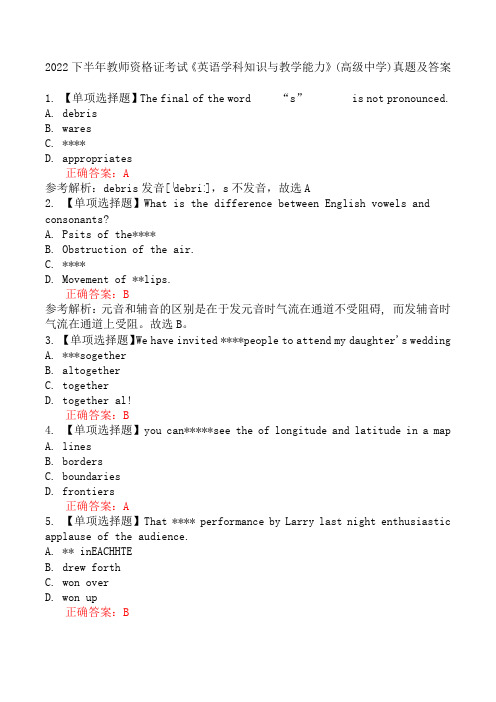
2022下半年教师资格证考试《英语学科知识与教学能力》(高级中学)真题及答案1. 【单项选择题】The final of the word “s”is not pronounced.A. debrisB. waresC. ****D. appropriates正确答案:A参考解析:debris发音[ˈdebriː],s不发音,故选A2. 【单项选择题】What is the difference between English vowels and consonants?A. Psits of the****B. Obstruction of the air.C. ****D. Movement of **lips.正确答案:B参考解析:元音和辅音的区别是在于发元音时气流在通道不受阻碍, 而发辅音时气流在通道上受阻。
故选B。
3. 【单项选择题】We have invited ****people to attend my daughter's weddingA. ***sogetherB. altogetherC. togetherD. together al!正确答案:B4. 【单项选择题】you can*****see the of longitude and latitude in a mapA. linesB. bordersC. boundariesD. frontiers正确答案:A5. 【单项选择题】That **** performance by Larry last night enthusiastic applause of the audience.A. ** inEACHHTEB. drew forthC. won overD. won up正确答案:B6. 【单项选择题】The interview success rate by language*** did not differ notably,was ***much difference ** the success rate by job typeA. norB. ***C. neitherD. or正确答案:A7. 【单项选择题】He wasn't appointed chairman of thecommittee, not very****popular with all its members.A. to consideredB. being consideredC. beny consideredD. having considered正确答案:B参考解析:句子翻译为:他没有被任命为这个委员会的主席,因为在所有的成员中并不是那么受欢迎。
国家教师资格考试专用教材 英语学科知识与教学能力 高级中学 第一部分 语言知识与能力

3
中公窑教师考试
给人改变未来的力量
英语学科知识与教学能力·高级中学
皂赠 枣则蚤藻灶凿爷泽冤等能与三类名词搭配遥 例如院 贼澡藻 遭燥燥噪渊泽冤袁 皂赠 遭燥燥噪渊泽冤袁 允燥澡灶爷泽 遭燥燥噪渊泽冤袁 葬灶赠 遭燥燥噪渊泽冤袁 葬灶赠 皂燥灶藻赠袁 憎澡燥泽藻 皂燥灶藻赠 渊圆冤 只能与单数名词搭配的限定词 有些限定词如 葬渊灶冤袁 燥灶藻袁 葬灶燥贼澡藻则袁 藻葬糟澡袁 藻增藻则赠袁 藻蚤贼澡藻则袁 灶藻蚤贼澡藻则袁 皂葬灶赠 葬袁 泽怎糟澡 葬 等只能与单数名
渊三冤名词的限定词
限定词是在名词词组中对名词中心词起特指尧 类指以及表示确定数量和非确定数量等限定作用 的词类遥
员. 限定词的种类 渊员冤 定冠词袁不定冠词袁零冠词院贼澡藻袁 葬袁 葬灶 渊圆冤 物主限定词院皂赠袁 赠燥怎则袁 澡蚤泽袁 澡藻则袁 燥怎则袁 赠燥怎则袁 贼澡藻蚤则袁 燥灶藻爷泽袁 蚤贼泽 ... 渊猿冤 名词属格院允燥澡灶爷泽袁 皂赠 枣则蚤藻灶凿爷泽 ... 渊源冤 指示限定词院贼澡蚤泽袁 贼澡葬贼袁 贼澡藻泽藻袁 贼澡燥泽藻袁 泽怎糟澡 渊缘冤 关系限定词院憎澡燥泽藻袁 憎澡蚤糟澡 渊远冤 疑问限定词院憎澡葬贼袁 憎澡蚤糟澡袁 憎澡燥泽藻 渊苑冤 不定限定词院灶燥袁 泽燥皂藻袁 葬灶赠袁 藻葬糟澡袁 藻增藻则赠袁 藻灶燥怎早澡袁 藻蚤贼澡藻则袁 灶藻蚤贼澡藻则袁 葬造造袁 遭燥贼澡袁 澡葬造枣袁 泽藻增藻则葬造袁 皂葬灶赠袁 皂怎糟澡袁 渊葬冤 枣藻憎袁 渊葬冤 造蚤贼贼造藻袁 燥贼澡藻则袁 葬灶燥贼澡藻则 ... 渊愿冤 基数词尧序数词尧倍数词和分数词院贼憎燥袁 枣蚤则泽贼袁 twice袁 one third ... 渊怨冤 量词院葬 造燥贼 燥枣袁 造燥贼泽 燥枣袁 责造藻灶贼赠 燥枣袁 葬 早则藻葬贼 燥枣袁 葬 早燥燥凿 凿藻葬造 燥枣袁 葬 造葬则早藻 燥枣袁 葬 泽皂葬造造 葬皂燥怎灶贼 燥枣袁 葬 择怎葬灶贼蚤贼赠 燥枣袁 葬 早则藻葬贼 燥枣袁 葬 早燥燥凿 灶怎皂遭藻则 燥枣 ... 圆. 限定词与名词的搭配关系 限定词的选择决定于随后的名词的类别袁是单数名词尧复数名词袁还是不可数名词遥 渊员冤 能与三类名词搭配的限定词 有些限定词如 贼澡藻袁 泽燥皂藻袁 葬灶赠袁 灶燥袁 燥贼澡藻则袁 憎澡燥泽藻 以及 皂赠袁 赠燥怎则 等物主限定词和名词属格渊允燥澡灶爷泽袁
教师资格证《英语学科知识与教学能力(高级中学)》(题库)模拟试卷四
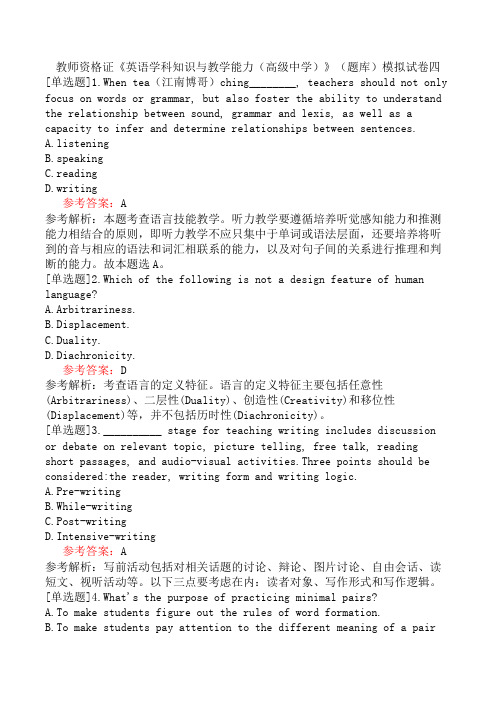
教师资格证《英语学科知识与教学能力(高级中学)》(题库)模拟试卷四[单选题]1.When tea(江南博哥)ching________, teachers should not only focus on words or grammar, but also foster the ability to understand the relationship between sound, grammar and lexis, as well as a capacity to infer and determine relationships between sentences.A.listeningB.speakingC.readingD.writing参考答案:A参考解析:本题考查语言技能教学。
听力教学要遵循培养听觉感知能力和推测能力相结合的原则,即听力教学不应只集中于单词或语法层面,还要培养将听到的音与相应的语法和词汇相联系的能力,以及对句子间的关系进行推理和判断的能力。
故本题选A。
[单选题]2.Which of the following is not a design feature of human language?A.Arbitrariness.B.Displacement.C.Duality.D.Diachronicity.参考答案:D参考解析:考查语言的定义特征。
语言的定义特征主要包括任意性(Arbitrariness)、二层性(Duality)、创造性(Creativity)和移位性(Displacement)等,并不包括历时性(Diachronicity)。
[单选题]3.__________ stage for teaching writing includes discussion or debate on relevant topic, picture telling, free talk, reading short passages, and audio-visual activities.Three points should be considered:the reader, writing form and writing logic.A.Pre-writingB.While-writingC.Post-writingD.Intensive-writing参考答案:A参考解析:写前活动包括对相关话题的讨论、辩论、图片讨论、自由会话、读短文、视听活动等。
教师资格证考试大纲:《英语学科知识与教学能力》(初级中学)

教师资格证考试大纲:《英语学科知识与教学能力》(初级中学)为您整理了《教师资格证考试大纲:《英语学科知识与教学能力》(初级中学)》,希望对您有所帮助!在这里祝考生们都能取得好成绩!《英语学科知识与教学能力》(初级中学)考试大纲一、考试目标1.英语学科知识与能力具有扎实的英语语言基础知识和语言能力;具备从事初中英语教学所需要的英语语言能力;能理解有关英语国家的语言、历史和文化等相关知识。
2.英语学科教学知识与能力掌握外语教学基本理论、英语教学专业知识与国家英语课程标准内容等学科教学知识,并能用以指导初中英语教学。
3.英语学科教学设计能力能够根据英语学科特点,针对初中学生的认知特点、语言水平和学习需要选择并设计合理的教学内容,形成完整合理的教学方案。
4.英语学科教学实施能力理解初中英语课堂教学实施的基本原则和方法,具备实施语言课堂教学的基本能力;能够根据教学设计,结合教学实际情况,采用恰当的教学手段,引导学生进行有效学习。
5.英语学科教学评价知识与能力了解初中英语课堂教学评价的基本知识和方法,能够对学生的语言学习进行恰当的评价;了解教学反思的基本方法和策略,能够对自己的课堂教学实践进行反思,提出改进的思路。
二、考试模块内容与要求(一)语言知识与能力1.掌握英语语言的基础知识,了解语言研究中与英语教学相关的基本概念和知识,并能在课堂教学中加以运用。
2.具有良好的英语语言运用能力,包括用英语进行书面表达、获取教学资源和信息、表达思想情感和与学生良好沟通的能力;能够筛选并改编适合初中学生英语水平的语言材料。
3.能够在语篇中理解英语国家的语言、历史和文学等相关的社会文化知识。
(二)语言教学知识与能力1.了解外语教学基本理论,理解语言观、语言学习观、语言教学观等对初中英语教学的指导作用。
2.理解《义务教育英语课程标准(2011年版)》的目标内容(语言技能、语言知识、情感态度、学习策略和文化意识),以及课程标准的其他相关知识,并能在教学设计与实施中运用。
教师资格证考试-笔试-《英语学科知识与教学能力》(高中)-教材知识点整理-前半部分

【所使用的教材信息】:2019年下半年考试使用的教材;【注意】:打印前请注意排版以及文档中图片的大小是否合适;因内容较多,分成两个文档,这是前半部分!第一部分英语语言知识第一章语音知识第一节字母、音素和音标一、英文字母1、英文字母的发音:2、英文字母的分类:二、英语音素1、音素:音素是音的最小的单位,英语中有48个音素,按照发音时气流是否受阻,分为元音音素(20个)和辅音音素(28 个);2、元音音素的分类:①单元音和双元音:②根据设最高部分的位置,单元音可分为:③根据发音的长短,单元音可分为:④根据唇的圆展,单元音可分为:⑤根据舌抬起的高度,单元音可以分为:⑥根据口形的大小,单元音可分为:3、辅音因素的分类:①根据发音方式,辅音可分为:②根据发音部位,辅音可分为:③根据声带振动与否,辅音可分为:三、英语音标1、音标:音标是记录音素的符号,是音素的标写符号;其制定规则是:一个音素只用一个音标表示,而一个音标并不只表示一个音素;目前我国通用的国际音标共有48个,其中,元音音标20个,辅音音标28个;2、标音法:无声子音【p, k, t】在【s】后面会丧失送气的现象,如:peak和speak,其宽式标音是:/pi:k/和/spi:k/,其严式标音是:【phi:k】和【spi:k】;第二节语音是的结合及其变化一、音节1、音节:音节是读音的基本单位,一个元音音素可以构成一个音节,一个元音音素和一个或几个辅音音素结合也可以构成一个音节;一般来说,辅音音素不响亮,不能构成音节,但阴雨辅音音素中有一些响音,他们和辅音音素结合,也可以构成音节,如:[m][n][n][l]等;2、音节的划分:几个拼起来发音的字母较一个“音节”,音节有开音节、闭音节、半开音节之分,不同的单词有不同的音节划分;常见的划分音节的方法如下:3、音节的类型:⑴单音节:单音节词都重读;⑵双音节;⑶三音节;⑷多音节;⑸成音节:一个辅音因素加上一个/l/或/m/或/n/,构成成音节;4、重读音节:⑴开音节:包括绝对开音节和相对开音节;①绝对开音节:以发音的元音字母结尾的音节;如:me;②相对开音节:单个元音字母后面加单个辅音字母,再加一个不发音的字母e组成的重读音节;如:name;⑵闭音节:单个元音字母后面有辅音字母(r, w, y除外)且以辅音字母结尾的重读音节;如:bag;⑶-r音节:元音字母+r;如:car;⑷-re音节:元音字母+re;三、语音现象1、连读:在连贯地说话或朗读时,在同一个意群(即短语或从句)中,如果相邻的两个词前者以辅音音素结尾,后者以元音音素开头,就要自然地将辅音和元音相拼,构成一个音节,这就是连读;连读符号是:~;连读的类型如下:①辅音+元音:②元音+元音:③辅音+辅音:④r/re+元音:如果前一个词以r或re结尾,后一个词以元音开头,这时r/re要与后面的元音拼起来连读;如:They‘re my father~and mother.⑤不可连读:当短语或从句之间按意群进行停顿时,意群与意群之间即使有两个相邻的辅音与元音出现,也不可连读;2、爆破:①爆破;⑥爆破类型;3、重读:⑵句子重读:在句子中,一般重读的是实词,如名词、动词、形容词、副词等,不重读的多为虚词,如冠词、连词、感叹词等;4、弱读:5、语调:英语中有五种基本语调:升调()、降调()、升降调()、降升调()、平调();⑵降调:陈述句、特殊疑问句、表示命令的祈使句、问候用语、感谢用语以及感叹句一般都用降调;在并列句中,若前后两个分句关系紧密且是顺承关系,则用升降调,若两个分句同等重要,或联系不紧密,则都用降调;⑶升降调:主要用语表达“蔑视、嘲笑、惊奇、自满得意”等;⑷降升调:用来表示“不肯定、话中有话”,还可表示“警告、安慰、鼓励”等;6、同化:7、英美发音的区别:第二章词汇知识(看教材)第三章词法知识+第四章句法知识—会陆续单独整理第五章语言学知识第一节语言学绪论一、语言1、语言定义:语言是言语交际(verbal communication)的一种方式,是人类用于交流的一种任意的声音符号系统(a system of arbitrary vocal symbols)。
2020年教师资格证考试《英语学科知识与教学能力》(初级中学)真题及答案

2020年教师资格证考试《英语学科知识与教学能力》(初级中学)真题及答案1. 【单项选择题】Which of the following shows the correct stress of the wor(江南博哥)d “pedestrian”?A. /ˈpədestriən/B. /pədesˈtriən/C. /pədestriˈən/D. /pəˈdestriən/正确答案:D参考解析:本题考查语音学。
pedestrian 的重音在第二音节上。
[pəˈdestriən] 2. 【单项选择题】Which of the following words has a different stress pattern?A. FacilityB. CaterpillarC. CommunityD. Accompany正确答案:B参考解析:本题考查语音学。
题干意为以下哪个单词的重音与其他不同。
facility[fəˈsɪləti]、community[kəˈmjuːnəti]、accompany [əˈkʌmpəni] 的重音均在第二音节上,而 caterpillar[ˈkatəpɪlə]的重音在第一音节上。
3. 【单项选择题】Because of the strong sun the new drawing-room curtains have()from dark blue to grey.A. fadedB. paledC. faintedD. blurred正确答案:A参考解析:本题考查动词。
题干意为由于太阳光照强烈,新上色的窗帘从深蓝色褪色成了灰色。
表达褪色用 fade,pale 翻译为“发白,变白”;faint 翻译为“衰落,变得微弱”;blur 翻译为“模糊”。
4. 【单项选择题】Which of the following pairs of words are synonyms?A. Red-colorB. Tall-shortC. Petrol-gasolineD. Father-father正确答案:C参考解析:本题考查语义学。
教师资格证英语专业

第一部分语音知识1、元音vowel:单元音monophthong、双元音diphthong(1)按舌高部位的位置分:前元音front vowel、中元音central vowel、后元音back vowel (2)按发音的长短分:长元音long vowel、短元音short vowel;(3)按唇的园展分:圆唇元音rounded vowel、非圆唇元音unrounded vowel;(4)按舌抬起的高度分:高元音high vowel、中元音mid vowel、低元音low vowel;(5)按口型大小分:闭元音closed vowel、半闭元音semi-closed vowel、半开元音semi-open vowel、开元音open vowel2、辅音consonant:(1)按发音方式manner of articulation:塞音stop、擦音fricative、塞擦音affricate、鼻音nasal、边音lateral、近音approximant;(2)按发音部位place of articulation:双唇音bilabial、唇齿音labiodental、齿音dental、齿音后音post-alveolar、硬颚音palatal、软腭音velar、声门音glottal;(3)按声带振动vocal cord vibration:清辅音voiceless、浊辅音voiced(备注:两个或以上辅音连在一起的现象称为‘辅音连缀constant cluster’,如/tr/ /dz/)3、音节syllable的类型:单音节monosyllable、双音节disyllable、三音节three-syllable、多音节multisyllable、成音节syllabication(一个辅音加上一个/l/或/m/或/n/)、重读音节stressed syllable4、语音现象phonetic phenomena:连读、重读accent、语调intonation、爆破、同化assimilation、省音elision第五章语言学知识1、语言是言语交际(verbal communication)的一种方式,是人类用于交流的一种任意的声音符号系统(a system of arbitrary vocal symbols)。
英语学科知识与能力考试重点

英语学科知识与教学能力预测一、语音知识1.元音vowel[i:] h igh front tense unrounded vowel[І] high front lax unrounded vowel[u:] high back tense rounded vowel[ʊ]即[u] high back lax rounded vowel[З:]或[ə:] central tense unrounded vowel[ə] central lax unrounded vowel[e] mid-high front lax unrounded vowel[æ] low front lax unrounded vowel[Λ] mid-low back lax unrounded vowel[ɔ:] mid-low back tense rounded vowel[ɒ] low back lax rounded vowel[ɑ:] low back tense unrounded vowel双元音Diphthongs [eI] [aI] [ɔI] [əʊ] [aʊ] [Iə] [eə] [ʊə] A double movement produces 三元音Triphthong例如:tower中[aʊə]2. 辅音A chart of English consonantsA. Marsha was and always will beB. Marsha has to be and always will beC. Marsha had been and will always beD. Marsha has been and will always be【答案】D。
解析:本题考查时态。
四个选项中都有连词and连接两个时态,因此前后必须相互搭配,而ABC三项的前后两种时态搭配不当,因此选择D,现在完成时和将来时。
- 1、下载文档前请自行甄别文档内容的完整性,平台不提供额外的编辑、内容补充、找答案等附加服务。
- 2、"仅部分预览"的文档,不可在线预览部分如存在完整性等问题,可反馈申请退款(可完整预览的文档不适用该条件!)。
- 3、如文档侵犯您的权益,请联系客服反馈,我们会尽快为您处理(人工客服工作时间:9:00-18:30)。
英语学科知识与教学能力考点必背语音部分教师资格证修订版
IBMT standardization office【IBMT5AB-IBMT08-IBMT2C-ZZT18】
学科知识与教学能力笔记(英语)
一、语音考点
(一)元音Vowels
考点1:元音的舌位图
我们先来看看英语单元音的舌位图(P70)。
图的左方为口腔的前部,右方为其后部。
竖线把舌头分成前中后三个部分;横线表示牙床的开合程度,图中的圆点表示元音音素发音
时舌头抬得最高的那一部分在口腔中的位置。
单元音可按发音时舌头前、中、后哪一部分抬得最高而分成三类:前元音,中元音,后元音(back vowels)。
元音一般从四个方面进行描述:舌位(high, mid, low),舌头最高部位的位置(front, central, back),从图中可以看到,/i:/与/?/都是前元音,但是发/i:/时牙床近于全合;发/?/时,牙床近于全开。
可见,发音时调节口的开张程度就产生的不同的前元音。
长度(long, short)或紧张度(tense, lax),唇的开口度(rounded, unrounded)
音标描述汇总:
[i:] high front tense unrounded vowel
[?] high front lax unrounded vowel
[u:] high back tense rounded vowel
[?]即[u] high back lax rounded vowel
[З:]或[?:] central tense unrounded vowel [?] central lax unrounded vowel
[e] mid-high front lax unrounded vowel
[?] low front lax unrounded vowel
[Λ] mid-low back lax unrounded vowel
[?:] mid-low back tense rounded vowel
[?] low back lax rounded vowel
[ɑ:] low back tense unrounded vowel
考点2:专有名词
基本元音 Cardinal Vowels
纯元音Pure Vowels/单元音 Monophthong Vowels
滑元音Vowels glides :There is an audible change of quality. ——If a single movement of the tongue is involved, the glides are called 双元音Diphthongs
如:[eI] from mid-low front to high front
[aI] [?I] [??] [a?] [I?] [e?] [??] 略
A double movement produces 三元音Triphthong 例如:tower 中[a??]
(二)辅音Consonants
Consonants are sounds produced by constricting or
obstructing the vocal tract at some place to divert,
impede or completely shut off the flow of air in the oral cavity.
Vowels 元音: produced without such obstruction so no turbulence or a total stopping of the air can be perceived.
区别:the distinction between vowels and consonants lies in the obstruction of airstream.阻塞气流。
考点1:Manners of articulation发音方式
stops 爆破音 [p, b, t, d, k, g]
nasal鼻音 [m, n, ?]
fricative摩擦音 [f, v, θ, e, s, z, ∫, ?, h]、approximant近似音 [w, r, j ]、
lateral边音 [l]、
affricate塞擦音 [ts, dz, tr, dr]
考点2:Places of articulation发音部位
bilabial双唇音、labiodental唇齿、dental齿间、alveolar 齿龈、postalveolar齿龈后、retroflex卷舌音、palatal 硬腭、velar软腭、glottal声门[h].
总结:
[p] voiceless bilabial stop
[b] voiced bilabial stop
[t] voiceless alveolar stop
[d] voiced alveolar stop
[k] voiceless velar stop
[g] voiced velar stop
[m] bilabial nasal
[n] alveolar nasal
[?] velar nasal
[f] voiceless labiodental fricative [v] voiced labiodental fricative [?] voiceless dental fricative
[e] voiced dental fricative
[s] voiceless alveolar fricative [z] voiced alveolar fricative
[∫] voiceless postalveolar fricative [?] voiced postalveolar fricative [h] glottal fricative
[t∫] voiceless postalveolar affricate [d?] voiced postalveolar affricate
[l ] alveolar lateral
[r] alveolar approximant
[w] bilabial approximant
[j] palatal approximant
(三)Assimilation同化现象:a process by which one sound takes on some or all characteristics of a neighboring sound.
Nasalization鼻音化、cap can
Dentalization齿音、tent tenth
Velarization软腭 since sink
Voiced frication有声擦音→voiceless无声擦音
/__voiceless清音
five past/ has to/ have to [h?f tu ]
are all instances Assimilation. is often used synonymously with coarticulation协同发音If the sound becomes more like the following sound, as in the case of lamb, it is known as anticipatory coarticulation(先期协同发音). If the sound shows the influence of the preceding sound, it is
perseverative coarticulation(后滞协同发音), as is the case of map.
(四)Suprasegmental Features超音段特征
the aspects of speech that involve more than single sound segments. The principal suprasegmental features 特征are syllable音节, stress重音, tone声调, and intonation语调
考点:重音Stress
In general situations, notional words实词are normally stressed while structural words虚词are unstressed.。
